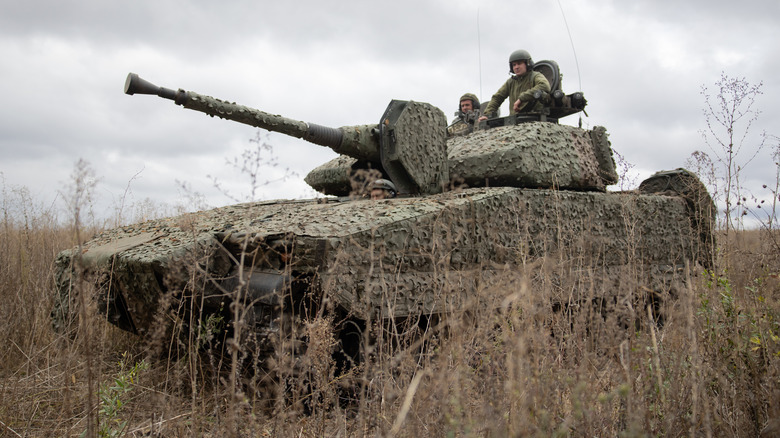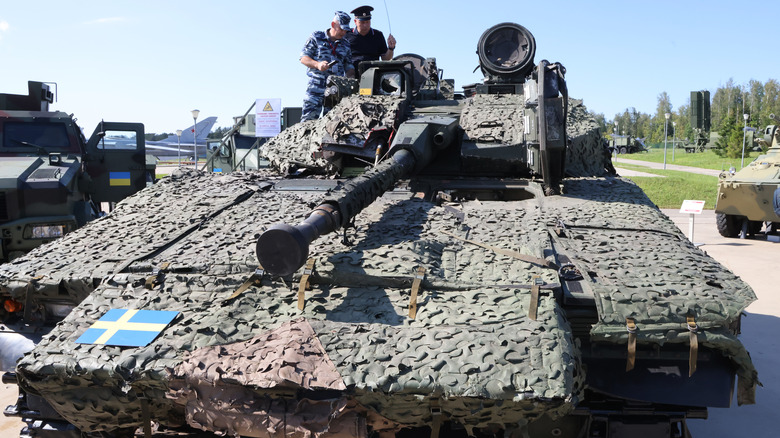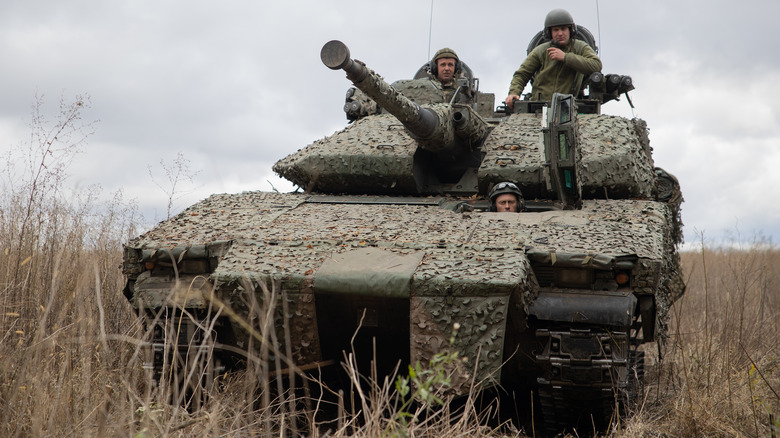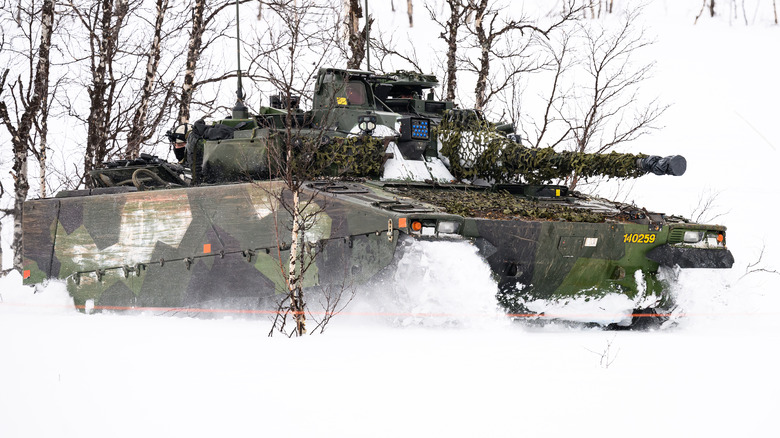Here's Why The Swedish CV-90 Is Touted As The Best Fighting Vehicle Ever
Since Russia invaded Ukraine in 2022, various nations have supplied the beleaguered nation with all manner of arms and armaments. Most of the media's attention has been on American, German, and British tanks, anti-aircraft weapons, and artillery. One vehicle that hasn't received as much attention is arguably one of the most important in the conflict: The Swedish-made Combat Vehicle 90, or CV-90, armored infantry fighting vehicle (IFV).
Sweden first used the CV-90 in the 1990s and has since built more than 1,400 in 17 different variations, many of which were exported to other countries. One thing that makes the CV-90 such a desirable armored option is how often Sweden has upgraded it. Since its introduction in 1993, Sweden has put the CV-90 through multiple upgrades and refits, beginning with the Mk 0 to the currently-used Mk IV. Each new Mk design integrated modern advancements, ensuring the CV-90 remained a relevant vehicle on the battlefield.
Sweden doesn't merely sell the CV-90; it also assists with its construction elsewhere. In August 2023, Sweden announced a plan to begin production of CV-90s in Ukraine with the goal of producing 1,000. It's unclear how many CV-90s Ukraine produced domestically, but it's clear the nation received only around 50 CV-90s as of March 2024. Despite the small number of vehicles inside Ukraine, the CV-90 has proven its worth as one of the most effective fighting vehicles used in the conflict to date.
What is the CV-90?
There are several variations in the design and utilization of the CV-90, though Ukraine's version is the CV9040C as well as the CV9035NL Mid-life update (MLU), which is also used by the Netherlands. These versions of the CV-90 were first developed in 2021. The new version is used primarily for export and is a 37-ton armored IFV capable of carrying 11 personnel. Each vehicle costs around $9 million, and they come with commander-stabilized thermal vision as well as several impressive features.
The CV-90 features a laser rangefinder capable of identifying targets up to six miles. The gunner and commander have thermal sights, and the vehicle is also equipped with Israel's Iron Fist active protection system capable of intercepting and destroying enemy missiles and high-explosive rounds, though it's unclear if the Ukrainian version also features this upgrade. In terms of armament, the CV-90 boasts a powerful Swedish 40 mm Bofors L/70 autocannon or American-made 35mm Bushmaster Mk III.
The Bushmaster cannon fires armor-piercing, fragmentation, and sabot rounds. The weapon is powerful, and due to its small bore, the vehicle carries a lot of ammunition. Additional armaments include two Spike LR anti-tank missiles, an upgraded turret, six 76mm grenade launchers, and a coaxial 7.62x40 mm machine gun. It can reach speeds of 43 mph and features an infrared adaptive camouflage called ADAPTIV, which makes it possible to look like an ordinary vehicle to thermal sights.
Why the CV-90 is dominating Ukrainian battlefields
Ukraine's use of the CV-90 in combat against Russia has proven its worth. Ukrainian crews have spoken about their CV-90s and how they stand up to Russian armor in their country. According to a Ukrainian CV-90 commander in a UNITED24 interview, "The CV-9040C's bulked-up armor has withstood direct anti-tank mines and FPV-style kamikaze drone attacks in Ukraine." While several CV-90s have been significantly damaged while fighting in Ukraine, no Ukrainian personnel were killed due to the vehicle's impressive defense capabilities.
CV-90 operators touted the IFVs features that make it a useful tool on the battlefield. Specifically, some appreciated the presence of a kettle and reheaters, enabling the preparation of rations from within the armored vehicle. Additionally, the CV-90 features seven dismounts with additional means of protecting its occupants. The dismount positions also allow for the opening of hatches so personnel can provide suppressing fire while the CV-90 is on the move, further extending its lethality.
Since its introduction to the Ukrainian front, the CV-90 has continuously excelled against its Russian counterparts. The CV-90 is somewhat similar to the Russian BMP-3, and they've engaged one another during the conflict. The T-90 and BMP-3 have a larger-bore main gun but have proven ineffective when facing off against the modernized CV-90. As Russia continues to lose armored vehicles in its war with Ukraine, the CV-90's effectiveness will improve. Russia's T-90 main battle tank has been slow to see replacements, leaving a void Ukraine is happy to fill with as many CV-90s as possible.
What the newest model CV-90 has to offer
Since its introduction in 1993, Sweden has updated and upgraded the CV-90 multiple times. There have been five generations, each with their respective MLUs, which are tailored for export, specific missions, terrain, and pretty much everything else engineers could think of to improve the CV-90. BAE Systems describes the CV-90 as "A vehicle that provides high tactical and strategic mobility, air defense, anti-tank capability, high survivability, and protection in any terrain or tactical environment."
To that end, BAE Systems' latest model, the CV-90 Mk IV, incorporates various updates that make the CV-90 as effective on the battlefield today as it was when it was first introduced. The Mk IV features a new engine capable of 1,000 horsepower alongside an upgraded transmission. The vehicle's weight has been increased to 38 tons, offering additional payload opportunities without sacrificing speed via the new engine. It also boasts a qualified Active Protection System (APS).
Other improvements made for the Mk IV include new D-series turrets with anti-tank guided missiles alongside the APS. The CV-90 Mk IV also features active damping technology that increases its speed on different terrains, and the CV-90's Electronic Architecture has been upgraded to the fourth generation, improving the ability to integrate future technologies. All these improvements keep the vehicle lethal for battlefield operations in a variety of environments, and ensure the CV-90 retains its status as the best IFV in use today.



